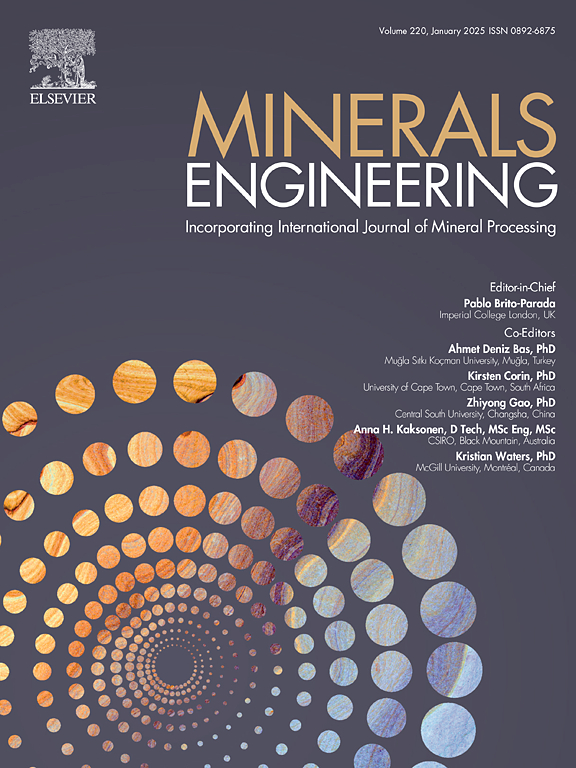新型脂肪酸捕收剂在磷灰石、白云石和方解石表面的吸附选择性研究
IF 4.9
2区 工程技术
Q1 ENGINEERING, CHEMICAL
引用次数: 0
摘要
尽管油酸捕收剂是磷灰石浮选的常用捕收剂,但其选择性不足。为了解决这一问题,本研究引入了一种新的脂肪酸捕收剂——α-磺酸基混合酸(α-SMA),它是一种含有α-磺酸基的C16至C18脂肪酸的混合物,作为油酸的替代品。通过浮选实验比较α-SMA捕收剂和油酸捕收剂的选择性。通过zeta电位测试和总有机碳(TOC)分析,定量了α-SMA在磷灰石、白云石和方解石上的吸附能力。利用x射线光电子能谱和第一性原理计算表征了α-SMA在矿物表面的吸附强度和构型。结果表明,α-SMA在磷灰石正浮选过程中的选择性优于油酸。其中,磷灰石的浮选回收率比白云石和方解石高80%以上。这种选择性的增强源于α-SMA在磷灰石上的吸附量高于白云石和方解石。TOC分析表明,在特定条件下,α-SMA在磷灰石上的吸附量几乎是白云石和方解石的两倍。吸附构型优化表明,α-SMA在白云石和方解石表面呈平行吸附取向,其C链与矿物表面几乎平行。这种平行结构解释了α-SMA对这两种矿物的收集能力较弱。本研究突出了α-SMA捕收剂在磷灰石浮选中的应用前景,为其工业应用奠定了基础。这也凸显了多极组集热器的重要研究和开发价值。本文章由计算机程序翻译,如有差异,请以英文原文为准。

Study on the adsorption selectivity of a novel fatty acid collector on apatite, dolomite, and calcite surfaces for improved flotation
Despite being a common choice for apatite flotation, oleic acid collector suffers from deficient selectivity. To resolve this constraint, this study introduces a novel fatty acid collector, α-sulfonate group mixed acid (α-SMA), a blend of C16 to C18 fatty acids containing an α-sulfonate group, as a replacement for oleic acid. This study compares the selectivities of α-SMA and oleic acid collectors through flotation experiments. The adsorption capacities of α-SMA on apatite, dolomite, and calcite were quantified using zeta potential tests and total organic carbon (TOC) analysis. X-ray photoelectron spectroscopy and first-principles calculations were used to characterize the adsorption intensities and configurations of α-SMA on mineral surfaces. The results demonstrate that α-SMA surpasses oleic acid in selectivity during apatite direct flotation. Specifically, the flotation recoveries of apatite can be above 80% higher than those of dolomite and calcite. This enhanced selectivity stems from the higher adsorption quantities of α-SMA on apatite relative to dolomite and calcite. TOC analysis indicates that, under specific conditions, α-SMA adsorbs on apatite at nearly twice the amounts observed on dolomite and calcite. Optimization of adsorption configurations reveals that α-SMA adopts a parallel adsorption orientation on dolomite and calcite surfaces, where its C chain aligns nearly parallel to the mineral surfaces. This parallel configuration explains the weak collecting abilities of α-SMA for these two minerals. This study highlights the promising potential of α-SMA collector in apatite flotation, providing a foundation for its industrial application. It also underscores the significant research and development value of collectors with multiple polar groups.
求助全文
通过发布文献求助,成功后即可免费获取论文全文。
去求助
来源期刊

Minerals Engineering
工程技术-工程:化工
CiteScore
8.70
自引率
18.80%
发文量
519
审稿时长
81 days
期刊介绍:
The purpose of the journal is to provide for the rapid publication of topical papers featuring the latest developments in the allied fields of mineral processing and extractive metallurgy. Its wide ranging coverage of research and practical (operating) topics includes physical separation methods, such as comminution, flotation concentration and dewatering, chemical methods such as bio-, hydro-, and electro-metallurgy, analytical techniques, process control, simulation and instrumentation, and mineralogical aspects of processing. Environmental issues, particularly those pertaining to sustainable development, will also be strongly covered.
 求助内容:
求助内容: 应助结果提醒方式:
应助结果提醒方式:


